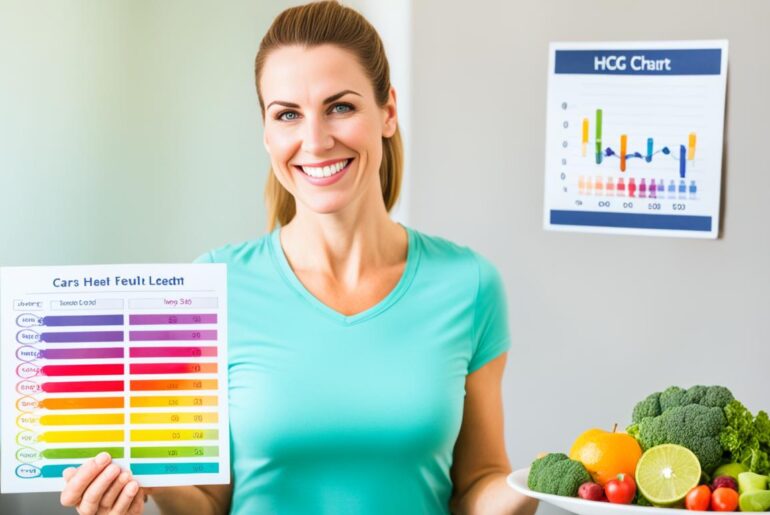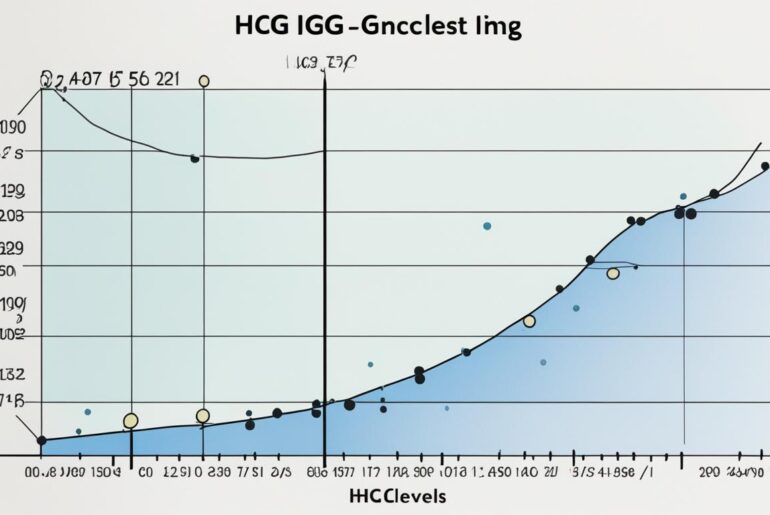Did you know that monitoring your progress during Phase 2 of the HCG diet is crucial for achieving effective weight loss? With the HCG Diet Phase 2 monitoring system, you can track your progress and ensure the success of your weight loss journey.
Phase 2 of the HCG diet involves following a 500-calorie intake and receiving HCG injections to accelerate fat burning. By closely monitoring your progress during this phase, you can gauge the effectiveness of the diet and make necessary adjustments to maximize your results.
In this article, I will guide you through the process of monitoring your progress during Phase 2 of the HCG diet. From setting goals to tracking measurements, you will learn the essential steps and tips for ensuring your weight loss success.
Key Takeaways:
- HCG Diet Phase 2 monitoring is crucial for effective weight loss.
- Tracking your progress during Phase 2 helps gauge the effectiveness of the diet.
- By monitoring and making necessary adjustments, you can maximize your weight loss results.
- Setting goals and tracking measurements are essential steps in Phase 2 monitoring.
- Stay committed and utilize charts and milestones for motivation and progress tracking.
Understanding the HCG Diet Protocol
The HCG diet protocol is a scientifically designed weight loss approach that focuses on resetting the body’s Set-Point and enhancing fat burning. Central to this protocol is the administration of the HCG hormone, or Human Chorionic Gonadotropin, which is naturally produced by the body.
When HCG is introduced into the system, it offers a range of benefits that contribute to the success of the HCG diet:
- Hunger suppression: HCG helps decrease hunger levels, making it easier to adhere to the low-calorie intake during the diet.
- Energy balance: By balancing the body’s energy, HCG ensures that you have the necessary stamina and vitality throughout the diet.
- Abnormal fat burning: HCG targets and burns abnormal fat stores in the body, such as those deposited in stubborn areas like the hips, thighs, and abdomen.
- Muscle mass preservation: While on a calorie-restricted diet, HCG facilitates muscle preservation, preventing muscle loss and ensuring that the weight loss primarily comes from fat.
The HCG diet protocol, when followed correctly, enables individuals to achieve significant and sustainable weight loss results. By leveraging the power of the HCG hormone, this protocol provides a comprehensive approach to shedding excess pounds and improving overall well-being.
Placing the image above reinforces the concept of fat burning, which is an integral part of the HCG Diet Protocol.
Phases of the HCG Diet

The HCG diet follows a structured approach consisting of three key phases: the Loading Phase, Weight Loss Phase, and Maintenance Phase.
The HCG Diet Phases are designed to optimize weight loss and promote long-term success. Let’s take a closer look at each phase:
Loading Phase
The Loading Phase is the initial stage of the HCG diet. During this phase, individuals consume high-calorie and high-fat foods, while also receiving HCG injections. This phase typically lasts for two days and serves a crucial purpose in preparing the body for the Weight Loss Phase.
While it may seem counterintuitive to indulge in calorie-dense foods at this stage, it is essential to build up fat stores. This allows the HCG hormone to effectively tap into these reserves to fuel the body during the subsequent phases. The Loading Phase sets the stage for rapid weight loss and optimal fat burning.
Weight Loss Phase
The Weight Loss Phase is the core of the HCG diet journey. It involves a low-calorie diet of approximately 500 calories per day, coupled with regular HCG injections. This phase typically lasts for 3-6 weeks, depending on individual goals and progress.
During this phase, the body enters a metabolic state known as ketosis, where it predominantly burns fat for energy. The combination of the low-calorie diet and HCG injections helps curb hunger, preserve muscle mass, and promote rapid weight loss.
To support healthy and sustainable weight loss, it is crucial to adhere to the approved foods list, which includes lean protein sources, specific vegetables, and fruits. Portion control and mindful food choices play a critical role in achieving optimal results during the Weight Loss Phase.
Maintenance Phase
The Maintenance Phase is the final stage of the HCG diet. It focuses on gradually increasing calorie intake while maintaining the achieved weight loss. This phase aims to stabilize the body at the new weight set point, ensuring long-term success and preventing weight regain.
During the Maintenance Phase, individuals gradually increase their caloric intake to 1500-2000 calories per day, following a balanced and nutritious meal plan. This phase allows for more dietary flexibility while emphasizing healthier food choices and portion control.
Regular exercise and ongoing lifestyle changes are also key components of the Maintenance Phase. By incorporating physical activity and making sustainable dietary choices, individuals can maintain their weight loss and enjoy improved overall health and wellness.
Understanding and successfully navigating each phase of the HCG diet is essential for achieving optimal results and long-lasting weight loss. By following the prescribed guidelines, individuals can experience transformative changes in their health, well-being, and body composition.
Preparing for Phase 2 Monitoring
As you embark on Phase 2 of the HCG diet, it’s crucial to prepare yourself mentally for the journey ahead. Recognizing the need to lose weight and setting clear goals will lay the foundation for success. Mental preparation helps you stay focused and motivated throughout the phase.
One practical step to take is creating a food inventory. This involves making a detailed list of the approved foods and ingredients you’ll need for your meals. By taking the time to calculate quantities required for the diet, you can ensure you have everything on hand when it’s time for grocery shopping and meal preparation.
Meal preparation plays a significant role in ensuring a smooth experience during Phase 2. Planning and preparing your meals in advance can save time and help you stick to your calorie allowance. By having your meals ready, you eliminate the temptation to reach for unhealthy options when hunger strikes.
Before you start Phase 2, it’s important to know your starting weight. This allows you to accurately track your progress throughout the phase. Keeping a record of your weight each morning helps you stay motivated and provides valuable insights into your weight loss journey.
By mentally preparing yourself, creating a food inventory, preparing meals in advance, and knowing your starting weight, you’ll be well-equipped to monitor your progress during Phase 2. These steps set the stage for a successful weight loss journey and help you achieve your desired results.
Phase 1: Loading (Gorging)

The Loading Phase of the HCG Diet is the initial stage that lasts for two days. During this phase, participants consume high-calorie and calorie-dense foods to prepare their bodies for the upcoming calorie restriction in Phase 2. This phase involves indulging in foods that are typically restricted in the diet, including fatty meats, fried foods, and sugary treats.
While it may seem counterintuitive to consume calorie-dense foods before starting a weight loss program, this phase plays a critical role in jumpstarting the body’s metabolism and fat-burning mechanisms. By temporarily increasing calorie intake, the body is signaled to release stored fat more efficiently during Phase 2, resulting in effective weight loss.
Participants also receive HCG injections during the Loading Phase. These injections help regulate hunger and support the body’s ability to burn abnormal fat stores while preserving muscle mass.
Throughout Phase 1, it is important to monitor and document your progress by weighing yourself each morning. This allows you to track your weight loss journey and make adjustments if necessary. Keeping a record of your weight loss progress can provide motivation and help you stay on track during the rest of the HCG Diet.
Sample Loading Phase Menu
| Meal | Food Items | Calories |
|---|---|---|
| Breakfast | Bacon, eggs, toast with butter | 600 |
| Snack | Ice cream sundae | 800 |
| Lunch | Cheeseburger, fries, milkshake | 1200 |
| Snack | Potato chips, chocolate bar | 1000 |
| Dinner | Pizza, wings, soda | 1500 |
Remember, the Loading Phase is a temporary portion of the HCG Diet and should be followed strictly for the designated two days. Once Phase 2 begins, you will transition to a low-calorie diet and eliminate high-calorie and calorie-dense foods from your meals. By correctly following each phase of the HCG Diet, you can achieve your weight loss goals and improve your overall health and well-being.
Phase 2: Low-Calorie Diet
Phase 2 of the HCG Diet is where the real weight loss happens. During this phase, you will follow a strict low-calorie diet, consuming only 500 calories per day. The purpose of this phase is to maximize fat burning while preserving muscle mass.
On the HCG Diet Phase 2, it’s important to choose your food wisely. The approved food list includes lean protein sources, such as chicken, turkey, and lean cuts of beef. These protein sources provide essential amino acids and help keep you feeling satisfied.
When it comes to vegetables, you have a variety of choices. Opt for nutrient-dense options like spinach, lettuce, cucumbers, and tomatoes. These vegetables are low in calories but rich in vitamins, minerals, and fiber.
As for fruits, select options that are low in sugar and high in fiber. Some suitable choices include apples, strawberries, and grapefruits. These fruits provide natural sweetness and can help satisfy your cravings for something sweet.
During Phase 2, portion control is vital. Be mindful of the quantities you consume to ensure you stay within the 500 calorie limit. This will help optimize your weight loss results and keep you on track towards your goals.
Below is an example of a typical HCG Diet Phase 2 food list:
| Protein Sources | Vegetable Choices | Fruit Options |
|---|---|---|
| Chicken breast | Spinach | Apple |
| Turkey breast | Lettuce | Strawberries |
| Lean beef | Cucumbers | Grapefruit |
Remember, sticking to the approved food list and practicing portion control are key to success during Phase 2 of the HCG Diet. By following the guidelines and making careful food choices, you can achieve your weight loss goals.
Phase 2: Monitoring Steps

During Phase 2 of the HCG diet, monitoring your progress is crucial to ensure effective weight loss and track your journey towards your goals. Daily weigh-ins and measurement tracking will help you stay motivated and on track.
Weigh Yourself Daily
One of the key monitoring steps during Phase 2 of the HCG diet is weighing yourself every day. It is recommended to weigh yourself in the morning, after waking up and eliminating waste, to get the most accurate measurement. Consistency is important, so make sure to wear similar outfits during each weigh-in. By monitoring your weight daily, you’ll be able to see the trends and progress of your weight loss journey.
Track Your Measurements
In addition to daily weigh-ins, tracking your measurements is another important aspect of monitoring progress during Phase 2 of the HCG diet. Measure your waist, hips, arms, and legs using a measuring tape, and record these measurements regularly. Tracking your inches lost can provide additional motivation and a more comprehensive picture of your progress.
By keeping a record of your weight loss and inch measurements, you’ll be able to see how your body is transforming and stay motivated as you see progress over time.
| Tracking Steps | Frequency |
|---|---|
| Weigh-ins | Daily |
| Measurements | Weekly |
Phase 2: Monitoring Tips

To effectively monitor your progress during Phase 2 of the HCG Diet, it is crucial to set clear goals and stay committed to the dietary guidelines. Tracking your progress using charts and milestones can provide motivation and help you stay on track.
Setting goals: Before starting Phase 2, take some time to define your weight loss goals. Whether it’s a specific target weight or a desired clothing size, having a clear goal in mind will keep you focused and motivated throughout the diet.
Staying committed: The HCG Diet requires dedication and discipline. It’s important to remind yourself of your reasons for doing the diet regularly. Write down your motivations and refer back to them when you need a reminder to stay committed.
Utilizing charts and milestones: Creating a visual representation of your progress can be highly motivating. Use a chart to track your weight loss, measurements, and milestones reached. Celebrate each milestone as you get closer to your goal.
Remember, the first ten pounds lost may not be noticeable, but subsequent pounds will show more significant results. The key is to stay consistent and trust the process. Your hard work and dedication will pay off, leading to successful weight loss during Phase 2 of the HCG Diet.
Breaking Through Weight Plateaus

Weight plateaus are a common challenge for individuals on the HCG Diet. However, these plateaus can be overcome by implementing rapid calorie shifts and incorporating specific strategies into the diet plan. Two effective techniques for breaking through weight plateaus during the HCG Diet are the Apple Day and the Steak Day.
Apple Day
During an Apple Day, participants consume only apples for the entire day. This calorie-restrictive approach helps shock the body and kick-start the weight loss process. Apples are rich in fiber and water content, making them a nutritious and filling option. By focusing on apples for a day, individuals can reset their metabolism and promote further weight loss.
Steak Day
The Steak Day is another method for breaking through weight plateaus during the HCG Diet. On this day, participants restrict their carbohydrate intake and focus on consuming vegetables and a large serving of protein, such as steak, during the evening meal. By eliminating carbohydrates and increasing protein intake, this day helps shift the body into a fat-burning mode, stimulating weight loss.
Both the Apple Day and the Steak Day provide a rapid calorie shift, which can help overcome weight plateaus and reignite progress on the HCG Diet. It’s important to note that these techniques should be implemented under the guidance of a healthcare professional or a registered dietitian to ensure they align with individual needs and goals.
Example Table: Apple Day vs. Steak Day
| Apple Day | Steak Day |
|---|---|
| Consumes only apples | Restricts carbohydrates |
| Shock the body and promote weight loss | Shifts the body into fat-burning mode |
| Fiber-rich and hydrating option | Increased protein intake |
Breaking through weight plateaus during the HCG Diet requires determination, adherence to the protocol, and strategic approaches like the Apple Day and the Steak Day. By utilizing these techniques, participants can overcome plateaus and continue progressing towards their weight loss goals.
Phase 3: Maintenance and Long-Term Success

Now that you have successfully completed Phase 2 of the HCG diet and achieved your weight loss goals, it’s time to transition into Phase 3 – the maintenance phase. This phase is crucial for ensuring long-term success and maintaining your hard-earned weight loss.
During Phase 3, you will gradually increase your calorie intake to a range of 1500-2000 calories per day. This increase in calories is essential for sustaining your metabolism and preventing your body from going into starvation mode. However, it’s important to make healthy food choices to support your ongoing weight maintenance journey.
When it comes to selecting your food options, focus on incorporating nutrient-dense foods that will provide your body with the necessary vitamins, minerals, and antioxidants. Opt for lean proteins, such as chicken, fish, and tofu, to help maintain muscle mass. Include a variety of vegetables, such as leafy greens, broccoli, and bell peppers, to ensure an adequate intake of fiber and micronutrients.
It’s also beneficial to include healthy fats in your diet, such as avocados, nuts, and seeds, as they support overall wellness and promote satiety. And don’t forget about the importance of hydration. Drink plenty of water throughout the day to keep your body properly hydrated and support optimal metabolic function.
Regular exercise
In addition to healthy food choices, incorporating regular exercise into your daily routine is crucial for sustained weight loss and overall well-being. Engaging in physical activity helps to maintain muscle tone, boost metabolism, and improve cardiovascular health.
Consider incorporating a combination of cardiovascular exercises, such as brisk walking, cycling, or swimming, with strength training exercises to build lean muscle mass. Aim for at least 150 minutes of moderate-intensity exercise or 75 minutes of vigorous-intensity exercise per week for optimal results.
Your journey doesn’t end with Phase 2 – it continues into Phase 3, where you learn to maintain a healthy lifestyle and enjoy long-term success.
Tracking your progress
Just like in Phase 2, monitoring your progress during Phase 3 is essential for staying on track and making adjustments if necessary. Weigh yourself regularly, preferably once a week, and keep a log of your weight to ensure you’re maintaining your desired weight range.
Remember, the goal of Phase 3 is to maintain your weight loss, not continue losing weight. If you notice any significant fluctuations or weight gain, it may be a sign that you need to make adjustments to your calorie intake or exercise routine.
Lastly, stay committed to your lifestyle changes and continue to make healthy choices even after you’ve completed Phase 3. This will help ensure that the weight you’ve lost doesn’t come back and that you continue to enjoy improved health and well-being in the long run.
| Phase 3 Tips | Benefits |
|---|---|
| Gradually increase calorie intake | Preserve metabolic function |
| Choose nutrient-dense foods | Support overall wellness |
| Include regular exercise | Maintain muscle tone and boost metabolism |
| Monitor progress and make adjustments | Stay on track and maintain weight loss |
| Make lifelong healthy choices | Enjoy sustained weight loss and improved well-being |
Conclusion
The HCG Diet Phase 2 monitoring is a crucial component for achieving successful weight loss and long-term health. By following the HCG diet protocol, individuals can experience permanent weight loss and improved overall wellness. The combination of a low-calorie diet, HCG injections, and diligent tracking of progress leads to sustainable results.
Throughout Phase 2, individuals must track their weight loss progress, make necessary lifestyle changes, and maintain motivation. Tracking progress through daily weigh-ins and measurements allows for accurate monitoring, allowing adjustments to be made when needed. This ensures that the HCG diet remains effective and personalized for each individual’s unique needs.
By adhering to the HCG diet and consistently monitoring their progress, individuals can achieve permanent weight loss and enjoy improved health and wellness. The HCG diet’s emphasis on resetting the body’s Set-Point and increasing the rate of fat burning leads to not only weight loss but also the preservation of muscle mass. This holistic approach to weight loss promotes overall well-being and a healthier lifestyle.
FAQ
What is the HCG diet?
The HCG diet is a weight loss protocol developed by Dr. A.T.W. Simeons to help patients return to a safer weight zone. It involves HCG injections and a low-calorie diet.
How does the HCG diet work?
The HCG diet works by resetting the body’s Set-Point and increasing the rate of fat burning. HCG, or Human Chorionic Gonadotropin, is a hormone that helps decrease hunger, burn abnormal fat, and preserve muscle mass.
What are the phases of the HCG diet?
The HCG diet consists of three phases: the Loading Phase, the Weight Loss Phase, and the Maintenance Phase.
How do I prepare for Phase 2 monitoring?
To prepare for Phase 2 monitoring, it is important to mentally prepare, create a food inventory, calculate quantities, and prepare meals in advance.
What is Phase 1 of the HCG diet?
Phase 1, also known as the Loading Phase, involves consuming high-calorie and calorie-dense foods while receiving HCG injections. Weighing progress is important during this phase.
What is Phase 2 of the HCG diet?
Phase 2, the Weight Loss Phase, involves a low-calorie diet of 500 calories per day, HCG injections, and strict portion control.
How do I monitor progress during Phase 2?
Monitoring progress during Phase 2 involves daily weigh-ins and tracking measurements. Keeping a record of weight loss and inches lost can help gauge progress.
What are some monitoring tips for Phase 2?
Some monitoring tips for Phase 2 include setting goals, staying committed to the diet, and utilizing charts and milestones for motivation.
How can I break through weight plateaus on the HCG diet?
Breaking through weight plateaus can be achieved through rapid calorie shifts, such as the Apple Day and the Steak Day.
What is Phase 3 of the HCG diet?
Phase 3, the Maintenance Phase, focuses on gradually increasing calorie intake, making healthy food choices, and maintaining metabolic function for long-term success.




